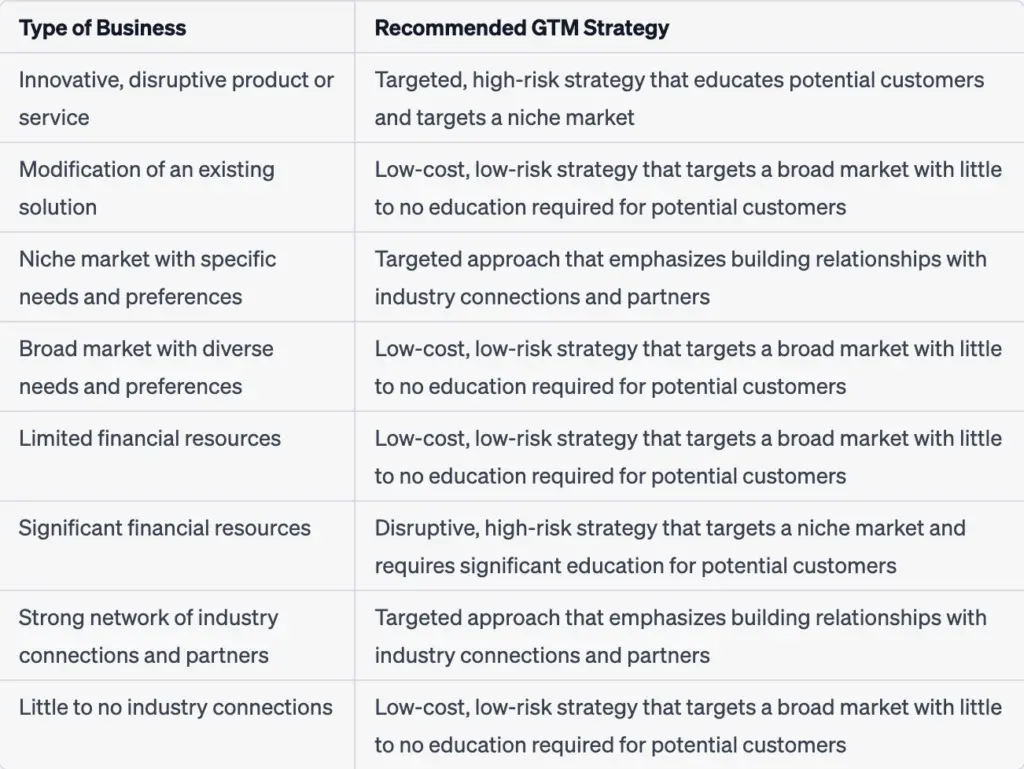Get Your Business Ready to Rock with a Killer Go-to-Market Strategy (GTM)
If you want your business to thrive in today’s fast-paced digital age, you need to have a solid go-to-market strategy (GTM) in place. But what exactly is a go-to-market strategy? Why is it essential for the success of your business? And how can you create one that truly rocks?
In this post, we’re going to dive deep into the world of GTM and help you create a killer strategy that will take your business to the next level.
What is a Go-to-Market Strategy (GTM)?
In simple terms, a go-to-market strategy (GTM) is a comprehensive plan that outlines how a company will reach its target customers and effectively sell its products or services. GTM involves a variety of different components, including product positioning, target market selection, pricing, sales channels, marketing, and more.
The primary goal of a GTM strategy is to ensure that a company’s products or services are effectively marketed and sold in a way that maximizes revenue and profits while also ensuring customer satisfaction. An effective GTM strategy is crucial for businesses of all sizes, from small startups to large corporations.
Why is a Go-to-Market Strategy (GTM) Essential?
Without a well-planned and executed GTM strategy, even the best product or service is unlikely to succeed in today’s crowded marketplace. A GTM strategy helps ensure that a company’s products or services are marketed and sold in a way that resonates with target customers and effectively communicates the value proposition of the offering.
By creating a GTM strategy, companies can minimize the risks associated with bringing a new product or service to market, and maximize their chances of success. A well-designed GTM strategy also helps companies better understand their customers and the competitive landscape, which can inform future product development and business decisions.
How to Create a Killer Go-to-Market Strategy (GTM)
Creating a killer GTM strategy requires careful planning and execution. Here are the steps you should follow to create a GTM strategy that rocks:
- Define Your Target Market: The first step in creating a GTM strategy is to define your target market. This involves identifying the specific customers who are most likely to buy your product or service, and understanding their needs, pain points, and preferences.
- Develop Your Value Proposition: Once you have identified your target market, you need to develop a clear value proposition for your product or service. This involves understanding what sets your offering apart from the competition and how it addresses the needs of your target customers.
- Choose Your Sales Channels: Next, you need to choose the sales channels that you will use to reach your target customers. This might include online channels, such as your website, social media, or e-commerce platforms, as well as offline channels, such as physical stores or sales reps.
- Determine Your Pricing Strategy: Your pricing strategy is a critical component of your GTM strategy. You need to determine the optimal price point for your product or service, taking into account factors such as production costs, competition, and customer demand.
- Develop Your Marketing Plan: Your marketing plan outlines how you will promote your product or service to your target customers. This might include tactics such as social media advertising, email marketing, content marketing, or influencer marketing.
- Test and Iterate: Finally, it’s important to test your GTM strategy and iterate based on customer feedback and market conditions. This might involve A/B testing different marketing messages or pricing strategies, or refining your product offering based on customer feedback.
Example of GTM strategy
An example of a go-to-market strategy (GTM) would be the launch of a new software product for small businesses. Here’s a breakdown of what a GTM strategy for this product might look like:
- Define the target market: The target market for the software product could be small business owners who need a user-friendly software to manage their finances and accounting.
- Develop a value proposition: The unique value proposition of the software could be its affordability, ease of use, and its ability to save small business owners time and money.
- Choose the sales channels: The software could be sold directly to customers via an e-commerce website, through partnerships with small business associations, or through a reseller network.
- Determine the pricing strategy: The software could be priced affordably, with different tiers of service offered at different price points, depending on the needs of the customer.
- Develop the marketing plan: The marketing plan could include social media advertising, targeted email campaigns, and partnerships with influencers in the small business space. The marketing materials should emphasize the value proposition and focus on the benefits that the software provides to small business owners.
- Test and iterate: As the product is launched, the GTM strategy should be constantly monitored and adjusted based on feedback from customers and sales data. This will help to ensure that the product is meeting the needs of the target market and that the GTM strategy is effectively reaching customers.
What are the different types of GTM strategies?
There are several types of go-to-market (GTM) strategies that businesses can use to launch new products, enter new markets, or grow their customer base. Here are some of the most common types of GTM strategies:
- Direct Sales: In this strategy, the business sells directly to the end customer through its own sales team or website. This strategy is often used for products that require a high level of customization or personalization.
- Channel Sales: In this strategy, the business sells its products through third-party distributors or resellers. This can be a cost-effective way to reach a larger customer base and can be useful for products that require less customization or are standardized.
- Online Sales: This strategy involves selling products or services directly to customers through an e-commerce website. This strategy is often used for products that can be easily shipped and do not require a lot of customization.
- Freemium Model: In this strategy, the business offers a basic version of its product for free, with the option for customers to upgrade to a paid version with additional features. This strategy can be effective for attracting new customers and building brand awareness.
- Viral Marketing: In this strategy, the business creates content or campaigns that are designed to be shared and spread rapidly through social media or other channels. This strategy can be effective for building brand awareness and attracting new customers.
- Strategic Alliances: In this strategy, the business partners with other companies or organizations to reach a larger customer base or access new markets. This strategy can be effective for expanding into new geographic regions or industries.
- Product-led Growth: In this strategy, the product itself is designed to drive customer acquisition and retention. This strategy is often used for software products or apps that offer a seamless user experience and encourage customers to share the product with others.
These are just a few examples of the different types of GTM strategies that businesses can use to achieve their goals. The most effective strategy will depend on factors such as the product or service being offered, the target market, and the competitive landscape.

Results
You should adopt a sales-led go-to-market & growth strategy.
#1. Is the price of your product?
Related Posts
Conclusion
Creating a killer GTM strategy is essential for the success of any business.
A well-designed GTM strategy helps companies better understand their target customers, the competitive landscape, and minimize the risks associated with bringing a new product or service to market. To create a GTM strategy that rocks, businesses should follow the six steps outlined above: defining their target market, developing their value proposition, choosing their sales channels, determining their pricing strategy, developing their marketing plan, and testing and iterating.
Remember that a GTM strategy is not a one-time event but rather a continuous process that requires ongoing monitoring and adjustment. As your business grows and evolves, your GTM strategy will need to adapt to new market conditions, customer needs, and competitive pressures.
In conclusion, a killer go-to-market strategy (GTM) is essential for the success of any business. By following the six steps outlined in this post, you can create a GTM strategy that effectively reaches your target customers, maximizes revenue and profits, and ensures customer satisfaction. So get started today and rock your business to success!

























